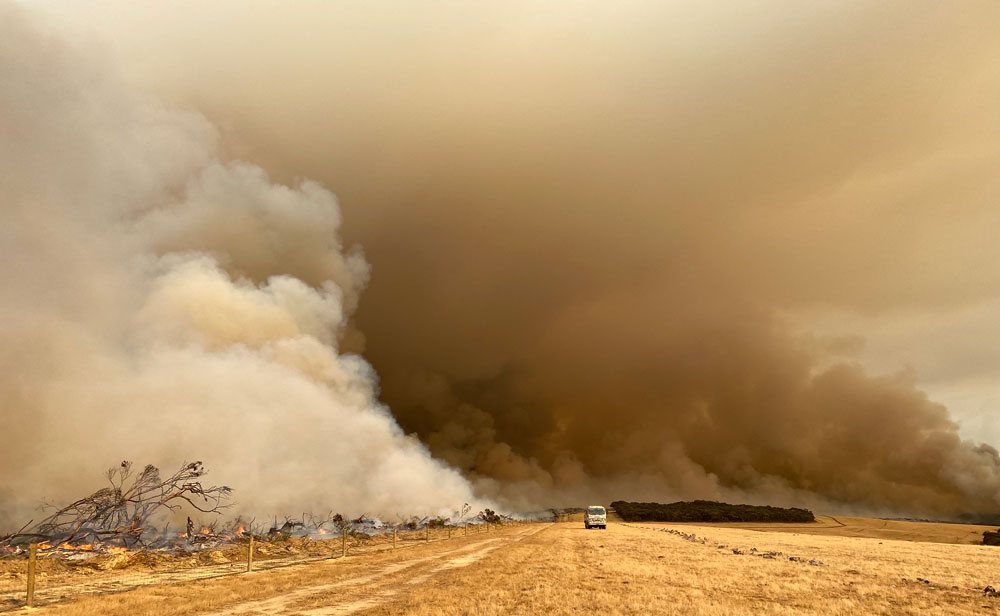
January 6, 2020; CNN and the New York Times
Australia is located “down under,” south of the equator, so it is summer there. And Australia is no stranger to hot summers. Still, when temperatures reached a record 120 degrees (48.9 degrees Celsius) last week in Penreth, a suburb west of Australia’s most populous city of Sydney, it confirmed again that this year’s summer is like no other. But most of all, there are the fires—at an unprecedented scale.
The Washington Post reports that in New Zealand, over 1,000 miles to the southeast, a “giant plume of smoke made its way across the Tasman Sea…by Sunday afternoon, it had blotted out the sun in Auckland, New Zealand, and tinted the light an ominous rust.” The smoke also “caramelized” previously white mountain snow.
The air quality ratings last week in Canberra, the Australian federal capital, were the stuff of science fiction novels, reaching 3,463 on a scale where 200 or greater is considered unhealthful. Monash, a suburb to Canberra’s south, reached a peak air quality rating of 4,650. Readings at one Canberra monitoring station reached 7,700 at one point on New Year’s Day.
CNN sought to tally the damage so far:
- Number of fires: 136, 69 not contained as of Monday
- 24 people dead, including three firefighters, and two more people are missing
- 480 million animals dead, including an estimated third of the koala population of New South Wales. (A third of the koalas’ habitat in that state is estimated to be gone, too.)
- 7 million acres burned so far (more than eight times the 1.8 million acres that California lost to fire during its record 2018 wildfire season)
- 1,300 homes destroyed in New South Wales (whose capital is Sydney) alone—the Los Angeles Times estimates a national loss of 2,000 homes.
In a military mobilization not seen in Australia since World War II, “about 3,000 army reservists, along with aircraft and naval ships, are being made available to help with the evacuation and firefighting efforts,” the New York Times reports. John Blaxland, a professor at the Strategic and Defense Studies Center at the Australian National University, tells the Times that “the country had not seen a catastrophe on this scale, affecting so many people in so many different locations, since Australia became independent in 1901.”
The Times details the extent of the conflagration:
- “The fires are blazing ferociously along Australia’s eastern coast, as well as South Australia, Tasmania, and parts of Western Australia.”
- “In southern Australia, fire tore through a popular nature reserve known for its koalas, sea lions and other wildlife, killing a man and his grown son.”
- “In towns along the coast between Melbourne and Sydney, shops closed, power was cut, and the authorities went door to door ordering evacuations.”
- “In Nowra, a coastal town two hours south of Sydney, the sky went dark as the air filled with choking smoke.”
“This is not a bush fire,” Andrew Constance, transport minister in New South Wales, told Australian Broadcasting Corporation radio. “It’s an atomic bomb.”
Sign up for our free newsletters
Subscribe to NPQ's newsletters to have our top stories delivered directly to your inbox.
By signing up, you agree to our privacy policy and terms of use, and to receive messages from NPQ and our partners.
And summer just began in Australia two-and-a-half weeks ago.
The long-term impact of the calamity remains to be seen. A report published shortly before the fires began, the 2020 Climate Change Performance Index, ranked Australia 57th of 57 countries in the strength of its climate polices. (The United States ranked next-to-last.)
At the Golden Globe awards on Sunday, Russell Crowe, absent due to the fires, had a statement read from the podium when he won an award. “Make no mistake,” it said, “the tragedy unfolding in Australia is climate change-based. We need to act based on science, move our global workforce to renewable energy, and respect our planet for the unique and amazing place it is. That way, we all have a future.”
Lorena Allum, an aboriginal Australian writing in the Guardian, laments:
It’s a particular grief, to lose forever what connects you to a place in the landscape. Our ancestors felt it, our elders felt it, and now we are feeling it all over again as we watch how the mistreatment and neglect of our land and waters for generations, and the pig-headed foolishness of coal-obsessed climate change denialists turn everything and everyone to ash.
Also writing in the Guardian, reporter Brigid Delaney notes that the fires could be a galvanizing moment, but cautions that once the fires die down, they might not be. “After rock bottom, there is a choice: stasis and misery or growth and transformation,” she writes.
Delaney recalls that many Australians assumed that after the massacre of school children at Sandy Hook in the US, “the National Rifle Association would lose much of its power and influence, its spokespeople and shills would become pariahs, and meaningful legislation would pass.” But stasis prevailed instead.
Now, she adds, Australia faces its Sandy Hook moment. “We must seize it and demand an effective climate policy. Or nature will be forced to teach us her hard lessons—over and over and over again.”—Steve Dubb











